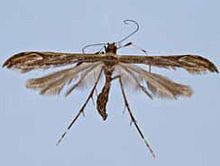| Hellinsia beneficus | |
|---|---|

| |
| Scientific classification | |
| Domain: | Eukaryota |
| Kingdom: | Animalia |
| Phylum: | Arthropoda |
| Class: | Insecta |
| Order: | Lepidoptera |
| Family: | Pterophoridae |
| Genus: | Hellinsia |
| Species: | H. beneficus |
| Binomial name | |
| Hellinsia beneficus (Yano & Heppner, 1983) | |
| Synonyms | |
| |
Hellinsia beneficus is a moth of the family Pterophoridae. It is native to Mexico, but was introduced to Hawaii in 1973 as a biological control agent against mistflower, Ageratina riparia.
Taxonomy
The species was identified by Kôji Yano and John B. Heppner in 1983 as Oidaematophorus beneficus. In 1995, it was transferred to the genus Leiptilus by Miller and Gielis and the species became known as Leioptilus beneficus. The genus is now recognised as Hellinsia and the species as H. beneficus.
Description
The wingspan is 22–28 millimetres (0.87–1.10 in). Adults are on wing in February and July, at an altitude of 450 to 1,350 metres (1,480 to 4,430 ft). The moth prefers higher altitudes and has rarely been observed below 460 m (1500 ft) by researchers in Hawaii.
The larvae feed on Ageratina riparia. Pupation takes place on leaves or in litter at the base of the plant or on the stem. The moth larvae create smooth edged holes in the plant's leaves, which stunt its growth. Because the A. riparia is highly invasive in tropical climates, the moth has been used as a biological control agent to slow its growth. Although the larvae are highly specific to A. riparia, they have also reportedly been found feeding on A. adenophora in Hawaii.
The parasitoid wasp, Meteorus laphygmae has been observed parasitizing the species' larvae in Hawaii.
Distribution
H. beneficus is native to Mexico, in the region which its larval host plant, A. riparia originates. The species of moth has since been introduced to other regions as a biological control agent against A. riparia. After collecting specimens from Mexico, unsuccessful attempts were made to introduce the species to Hawaii in 1959 and 1965. The moth was successfully introduced in Hawaii in 1973 when a total of approximately 1525 specimens from Contreras, Mexico were released at Mt. Kaala and Kona.
References
- Evenhuis, Neal L. (1996). Records of the Hawaii Biological Survey for 1995. Occasional Papers Bernice Pauahi Bishop Museum, No. 46. Vol. 2. p. 30. ISBN 9789996096532. OL 13343806M.
- Gielis, Cees (November 2011). "Neotropical species of the family Pterophoridae, part II". Zoologische Mededelingen. 85. ISBN 978-90-6519-001-7. Archived from the original on 2013-10-16. Retrieved 2011-12-22.
- ^ Yano, Kôji; Heppner, John B. (15 October 1983). "Description of Hamakua Pamakani Plume Moth from Hawaii (Lepidoptera: Pterophoridae)". Proceedings of the Hawaiian Entomological Society. 24 (2 & 3). Hawaiian Entomological Society – via University of Hawaiʻi at Mānoa Scholar Space.
- ^ Conant, Patrick (1998). "Scientific Note: A New Host Record for Oidaematophorus beneficus Yano & Happner (Lepidoptera: Pterophoridae)" (PDF). Proceedings of the Hawaiian Entomological Society. 33. Hawaiian Entomological Society: 151 – via CORE.
- ^ Muniappan, Rangaswamy; Reddy, Gadi V.P.; Raman, Anantanarayanan, eds. (2009). Biological Control of Tropical Weeds Using Arthropods. New York: Cambridge University Press (CUP). p. 68. ISBN 9780511507205.
- Nakao, H.K.; Funasaki, G.Y.; Davis, C.J. (1975). "Introductions for Biological Control in Hawaii, 1973". Proceedings of the Hawaiian Entomological Society. 22 (1). Hawaiian Entomological Society: 109–111 – via University of Hawaiʻi at Mānoa Scholar Space.
Further reading
- Yano, Kôji; Heppner, John B. (15 October 1983). "Description of Hamakua Pamakani Plume Moth from Hawaii (Lepidoptera: Pterophoridae)". Proceedings of the Hawaiian Entomological Society. 24 (2 & 3). Hawaiian Entomological Society: 335–341.
| Taxon identifiers | |
|---|---|
| Hellinsia beneficus | |